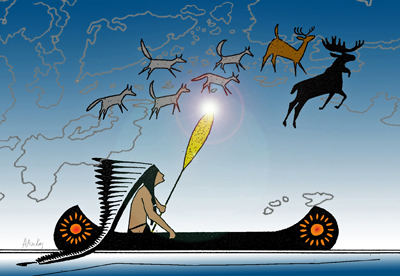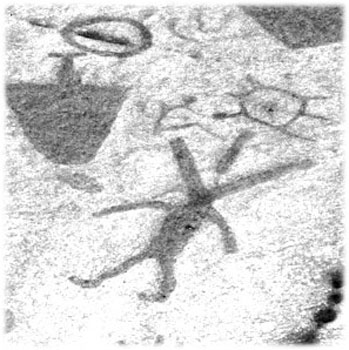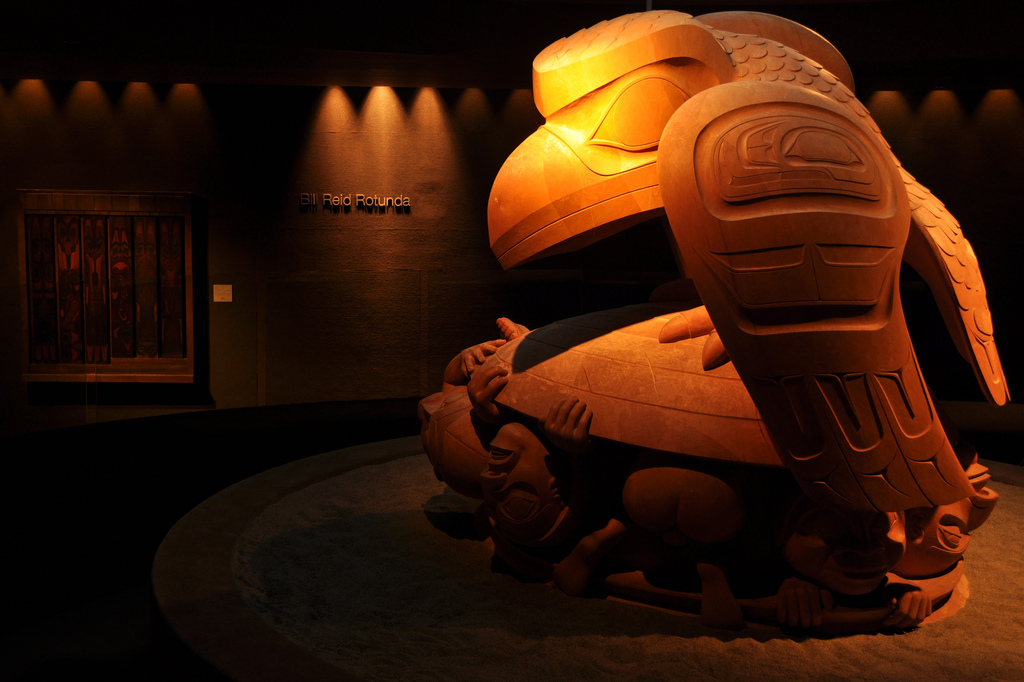Origin of the Term
Creek-Cherokee author Craig S. Womack argues that tricksters are not inherently Indigenous; rather, they were “invented by anthropologists.” Womack is referring to the fact that often non-Indigenous scholars (starting generally in the 1800s) created a convenient, catch-all phrase — the trickster — to label Indigenous figures and stories that might not always fit into this category. It is therefore important to recognize and appreciate that Indigenous communities construct tricksters in different ways.
Definition of Trickster
While a general definition of “trickster” can limit the complexity and cultural specificity of this figure from nation to nation, recognizing cross-cultural similarities can help to explain what tricksters are and why they are important to most Indigenous cultures in Canada.
A common characteristic is that tricksters are foolish and childlike troublemakers. Some are harmless, while others are malevolent. Tricksters like Nanabush and Wisakedjak are considered heroes. Both are powerful and wise leaders who sometimes get into trouble and play jokes on humans. By contrast, tricksters like Napi are sometimes depicted as selfish and cruel.
Another key defining feature of tricksters is that they wander, spiritually and physically. They often travel between the spirit world and the tangible world, as well as the areas in-between. During these travels, some tricksters, such as Raven and Coyote, alter their shape, manifesting as powerful, sacred beings, animals, inanimate objects (such as rocks and trees) and humans. In these cases, tricksters are also referred to in the literature as transformers or shape-shifters.
Tricksters in Indigenous Cultures
There are a wide variety of trickster figures in Indigenous cultures in Canada. The following are a few examples of tricksters from various parts of the country.
Among the Cree, Wisakedjak is an adventurous and humorous trickster, afforded prestige as a teacher to humankind. Wisakedjak is also rebellious. According to one story, he disobeyed the Creator, who asked Wisakedjak to keep the animals and humans from quarrelling. The result was the Creator’s flooding of the world, to begin life anew. While Wisakedjak played a role in the remaking of the world, some oral histories indicate that the Creator reduced his powers, leaving him with only the ability to flatter and deceive. Other stories reveal that Wisakedjak always had great powers and was responsible for creating the moon and other elements of our world.
Nanabush from the Ojibwe traditions is a half-human, half-spirit figure that appears in creation stories and is greatly respected and revered as a hero among various Anishinaabe peoples. Nanabush could change forms and often did so to play tricks on people. According to some tales, Nanabush is also described as two-spirited. Nanabush is immortalized in pre-colonial pictographs in a sacred location in Bon Echo Provincial Park on Mazinaw Lake in southern Ontario.
The Métis also have tales about Wisakedjak and Nanabush, as well as another trickster — Chi-Jean — described by some as a cousin or close friend of the other two. The travels and adventures of Chi-Jean, featured in various oral histories as well as a series of graphic novels for youth, seek to teach about Métis culture and the connection between humans and the earth.
Glooscap, huge in size and power, features in many stories of various Algonquian-speaking nations, such as the Mi’kmaq and Abenaki. Glooscap is said to have created natural features such as the Annapolis Valley, in the process often having to overcome his evil twin brother who wanted rivers to be crooked and mountains impassable.
Raven is an important trickster in the cultures of various Northwest Coast Indigenous peoples. Appearing in origin stories and other tales, Raven is valued as a guardian spirit. The Haida, Tlingit and Tsimshian have moieties (a type of kinship group) named for this figure. Raven also appears in Inuit stories, as does cultural hero Kiviuq. Described as a powerful wanderer and shaman, Kiviuq goes on many adventures, from tricking a hungry bear to kayaking through dangerous waters to encountering a giant bumblebee.
On the Prairies, the Siksika tell stories about Napi the trickster. Possessing great powers, Napi is credited by some Siksika people with creating the world and life within it. However, Napi is also foolish and can be cruel. Many stories describe him as possessing deceptive and destructive powers. In some Prairie and West Coast Indigenous tales, Napi is accompanied by another trickster: Coyote. Usually described as a pesky thief, Coyote is also a healer that received this special power from the Creator.
Purposes and Uses of Trickster Stories
Historically, trickster stories have served a variety of roles, from entertaining community members to transmitting traditional knowledge to teaching about right from wrong. Trickster stories illustrate the centrality of relationships between family members, clans and nations, while highlighting the tension between individual motivations and those of the larger social group. In bending the structures of society, tricksters reveal (and occupy) a realm in between those structures, one that demonstrates how social norms can be challenged, redefined and overturned.
In the modern era, the trickster has proved useful to those seeking a return to Indigenous approaches to learning. Educator Sylvia Moore wrote her book, Trickster Chases the Tale of Education (2017), in the style of a trickster story, contrasting Indigenous and non-Indigenous knowledges. She argues that the space between these two world views (the “trickster space”) may permit for a respectful and collaborative approach to Indigenous learning. Similarly, law professor John Borrows has argued that the trickster, when used as a framework for understanding Indigenous ways of knowing, can be helpful in the teaching of Indigenous rights and legal traditions. For example, he argues that Nanabush’s narratives can reveal “Anishinaabe law’s hidden cultural assumptions,” and by doing so, “Anishinaabe people gain access to… viewpoints within their legal tradition.”
Tricksters have also found a role in urban society among off-reserve Indigenous peoples who identify with the trickster as an adaptable but authentically Indigenous persona. Tricksters can be empowering figures for those who are generally left outside of traditional power structures. For example, writer Eden Robinson has used the trickster archetype in her novel, Son of a Trickster (2017), to challenge patriarchal power structures and Eurocentric notions of women’s sexuality and domesticity. Similarly, for two-spirit people, the trickster is a relatable identity; in some cultures, tricksters are non-gendered and consequently occupy the spaces in between traditional gender roles.
The Trickster in Canadian Literature
In the 1980s and 1990s, the trickster became a powerful symbol for those trying to celebrate Indigenous voices in Canadian literature. A variety of works about tricksters came out during this time, including Tomson Highway’s The Rez Sisters (1986), Daniel David Moses’s Coyote City (1988) and Thomas King’s Green Grass, Running Water (1993). A number of Indigenous artists formed the Committee to Re-establish the Trickster in the 1980s as a means of emphasizing the trickster’s role in Indigenous literature, while also offsetting stereotypical representations of Indigenous peoples in mainstream Canadian literature.
While the trickster continues to appear in modern Canadian literature, such as in Drew Hayden Taylor’s Motorcycles and Sweetgrass (2010) and Eden Robinson’s Son of a Trickster (2017), some contemporary scholars caution that the overuse of this figure can (or has) lead to the perpetuation of generic tricksters that are inauthentic to specific Indigenous nations. Edited by Deanna Reder and Linda M. Morra, Troubling Tricksters: Revisioning Critical Conversations (2010) encourages the appreciation and acknowledgement of culturally-specific approaches to Indigenous oral histories as opposed to vague “pan-tribal” tricksters.

 Share on Facebook
Share on Facebook Share on X
Share on X Share by Email
Share by Email Share on Google Classroom
Share on Google Classroom






